Interflam 2019
Group Members Participate in the 15th International Conference and Exhibition on Fire Science and Engineering
Six members of the NIST Fire Research Division (including three current or former members of the Flammability Reduction Group) recently traveled to the Royal Holloway College of London for the 15th International Conference and Exhibition on Fire Science and Engineering (Interflam 2019).
Dr. Isaac Leventon presented results (Fig.1) of a recent collaboration with Dr. Justin W. Bonny of the Department of Psychology at Morgan State University, which developed a methodology to quantify human decision making when presented with visual fire cues. This project also assessed the impact of various factors on human perceptions of fire risk. The results of this study suggest that judgments of visual cues can be used to examine how humans perceive a fire-related emergency, provide a framework to quantify occupant perceptions of fire scenarios, and may enable better prediction of evacuee behavior in fire scenarios.
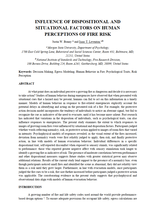
|
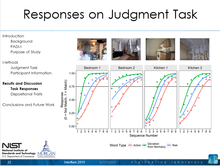
|
| Figure 1. Influence of Dispositional and Situational Factors on Human Perceptions of Fire Risk (Paper, center; presentation, right) |
|
Dr. Leventon also collaborated on a pair of related projects with Dr. Morgan C. Bruns of the Virginia Military Institute (a former member of the NIST Flammability Reduction Group). Their first presentation, delivered by Dr. Bruns, focused on a new methodology to extract pyrolysis kinetic parameters from thermogravimetric analysis (TGA) data (Fig. 2). The development of this methodology is motivated by a need to automate the determination of material properties for use in fire models. The algorithm is fully-automated and extremely efficient: a full set of kinetic parameters is provided in less than one second. The algorithm was validated using experimental data on Nylon 6,6, a flexible polyurethane (PU) foam, and polyvinyl chloride (PVC). The resultant kinetic parameters are tabulated and plots of the actual and predicted TGA data show that the algorithm is quite effective for one-, two-, and three-reaction mechanisms.
Their second presentation, delivered by Dr. Leventon, utilized this analysis tool to understand the thermal decomposition behavior of vegetative fuels (Fig. 3). In this work, thermal decomposition experiments - thermogravimetric analysis (TGA) and microscale combustion calorimetry (MCC) – were conducted on stems and leaves of six plant species commonly found across the United States. For each fuel, measurement data was analyzed to determine effective thermal decomposition mechanisms and the associated kinetics and heats of complete combustion of their constituent reactions. Between each fuel, distinct differences were measured in the onset temperature of decomposition, the temperature range of decomposition, the number of apparent reactions, and the peak measured mass loss and heat release rates (as well as the temperatures at which they occur). To analyze the impact of these variations on predictions of wildfire behavior, a modeling study was conducted in the NIST Fire Dynamics Simulator (FDS). This study demonstrated that model predictions of wildland fire spread have a significant dependence on fuel decomposition mechanism and the prescription of either a single, global heat of combustion or reaction-step-specific heats of combustion.
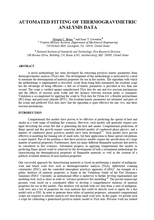
|
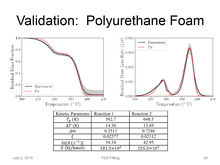
|
| Figure 2. Automated Fitting of Thermogravimetric Analysis Data (Paper, left; presentation, right) |
|
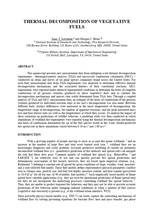
|
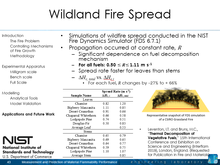
|
| Figure 3. Thermal Decomposition of Vegetative Fuels (Paper, left; presentation, right) |
|
These papers and presentations support multiple projects in the Fire Research Division including the Flammability Reduction Technologies Project and the Reduced Flammability of Residential Upholstered Furniture Project as well as ongoing development of the NIST Fire Dynamics Simulator (FDS). PDF copies of each of the conference papers and oral presentations highlighted here are available for download by clicking directly on Figs 1-3.
More information about Interflam 2019 is available at: https://www.intersciencecomms.co.uk/html/conferences/Interflam/if19/if19cfp.htm

